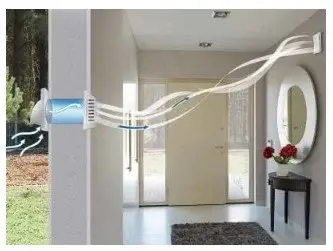Ventilation is a key aspect of ensuring a comfortable and healthy climate in the apartment. In urban environments, where many people live in apartment buildings, ensuring quality air exchange plays a critical role in maintaining the health and comfort of residents. In this article we will look at the importance of ventilation for an apartment , its types, advantages and possible ways of implementation.
The importance of ventilation
Health and well-being
Indoor air quality directly affects people's health. Insufficient ventilation can lead to the accumulation of harmful substances such as carbon dioxide (CO2), carbon monoxide (CO), volatile organic compounds (VOCs) and allergens. This can cause headaches, fatigue, allergic reactions and other health problems. This is especially true for people suffering from asthma and other respiratory diseases.
Comfort and productivity
Fresh air improves comfort and productivity. In stuffy, poorly ventilated rooms, concentration decreases, which is especially important for people working from home. Good ventilation helps maintain optimal temperature and humidity, creating favorable conditions for work and rest.
Protection from mold and mildew
In conditions of insufficient ventilation, humidity increases, which contributes to the development of mold and mildew. These microorganisms not only destroy building materials and furniture, but also pose a serious threat to health, causing allergic reactions and respiratory diseases. Maintaining optimal humidity levels through ventilation helps prevent these problems.
Types of ventilation systems
Natural ventilation
Natural ventilation is based on the principle of air movement through windows, doors and other holes. This method is the simplest and most accessible, but its effectiveness depends on a number of factors, such as climatic conditions, location of the apartment and the presence of drafts.
Advantages
Efficiency: Does not require installation and maintenance of complex technical systems.
Simplicity: Easily implemented and not requires special skills for operation.
Disadvantages
Dependency weather: Efficiency may be significantly reduced in hot or cold weather.
Limited adjustment: Difficult to control air exchange rate.
Forced ventilation
Forced ventilation involves the use of fans and other mechanical devices to circulate air. There are different types of forced ventilation:
Exhaust ventilation
The exhaust system removes polluted air from the room using fans. Typically installed in kitchens and bathrooms.
Advantages
Efficiency: Quickly and effectively removes contaminated air.
Control: Allows you to precisely regulate the intensity of ventilation.
Disadvantages
Energy intensity: Requires electrical energy to operate fans.
Cost: Installation and maintenance can be expensive.
Intake ventilation
The inlet system provides fresh air into the room. Typically used in combination with exhaust ventilation to create a balanced air exchange.
Advantages
Air quality: Provides fresh, filtered air.
Humidity control: Can be equipped with a humidity control function.
Disadvantages
Cost: Installation and maintenance can be expensive.
Difficulty: Requires professional installation and configuration.
Combined ventilation
The combined system combines elements of exhaust and supply ventilation, providing the best air exchange and control over air quality.
Advantages
-
Balance: Provides an optimal ratio of fresh and exhaust air.
Functionality: Can include filtration, heating and cooling of air.
Disadvantages
Cost: Most expensive to install and maintain.
Difficulty: Requires a professional approach to design and installation.
Ventilation solutions for apartments
Mechanical ventilation with heat recovery
Heat recovery is a technology that allows you to save heat





